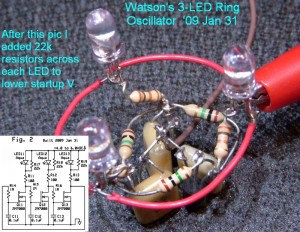This simple circuit acts somewhat like the LED Fader in that the LEDs do not turn on and off abruptly, however since the typical speed of the ring is faster than the fader, it’s harder to tell the turn-on and turn-off. It’s a fun circuit to build because of its simplicity and good visual effects. The circuit consists of three stages, each stage is identical to the others (see the schematic in the picture) .
.
Each stage is simple: an RC low pass filter, which is connected to the gate of a 2N7000 MOSFET. The LED and current limiting resistor are connected to the drain, and the source is connected to common negative. The low pass filter has the effect of shifting the phase of, or delaying the signal as it passes through, so the signal gets enough delay through the whole circuit to sustain oscillation. The values of the resistors and capacitors determine the speed of the LEDs turning on and off (for even speed, the values should be the same for all stages).
Since the MOSFET does not need any current to the gate, the resistors can be any value up to megohms or millions of ohms. This allows us to use smaller capacitors, so the 0.1 uF plastic capacitors will work well with 1 meg resistors, as shown here. The 2N7000 requires about 2 volts to turn the gate on so the minimum supply voltage has to be the LED forward voltage (2 volts for red, 3V for blue) plus the gate voltage, or 5 to 6 volts. The supply voltage can be lowered somewhat by putting a resistor across each LED (I used 22k).
The circuit will work with more stages, however the number of stages must be an odd number: 3, 5, 7, 9, etc. I built a 9 stage ring oscillator, but I later realized I could get a good enough effect by connecting every third LED in series and use only three stages. Of course the supply voltage has to be higher.
I tried to build a similar circuit using regular BJTs (bipolar junction transistors), but I couldn’t get it to oscillate. I read that they require a pushbutton switch across one of the capacitors to short it out and get the oscillations to start, but I didn’t like that it had to have someone start it up.
Thanks to Bill Sherman for leading me to this circuit. I blogged this before, I’ll have to see if I can find that blog.
Back to experimenting…